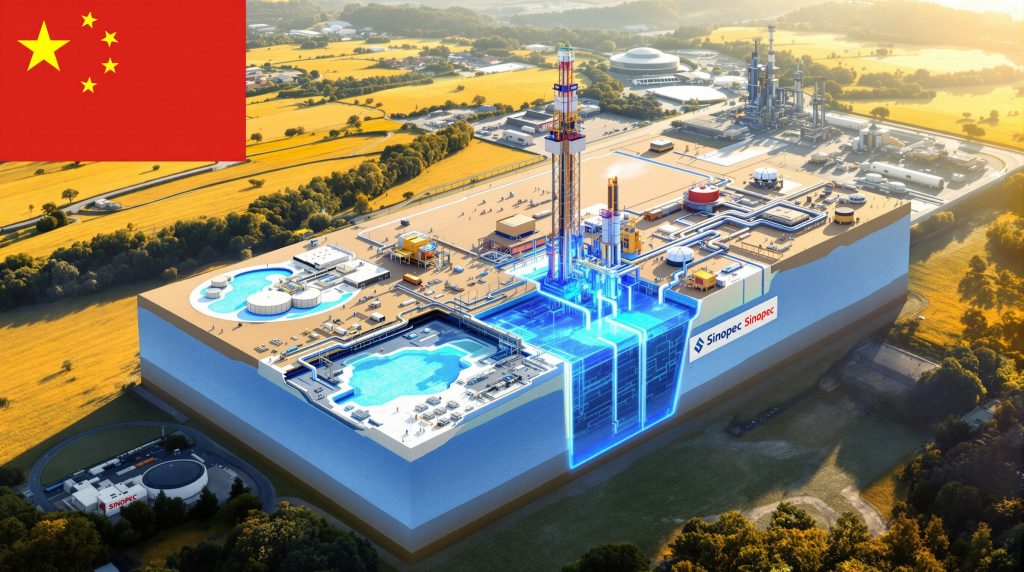How Are China's New Shale Gas Discoveries Transforming Its Energy Landscape?
China's energy landscape is undergoing a significant transformation with recent major shale gas discoveries in the southwest region. These discoveries represent crucial steps toward greater energy independence and security for a nation that has historically relied heavily on imports to meet its growing energy demands.
Recent Major Discoveries in Southwest China
The Hongxing field, spanning areas of Hubei province and Chongqing municipality, has recently been certified with an impressive 165 billion cubic meters (bcm) of natural gas reserves. This certification comes from China's Ministry of Natural Resources, confirming the field's substantial potential contribution to domestic energy supplies.
In parallel, the Yongchuan field has received certification for an additional 124.6 bcm of geological reserves. First discovered in 2016 with initial verified reserves of 23.5 bcm in 2019, this field continues to demonstrate expanding potential as modern exploration tech improves.
Both discoveries are strategically located in the resource-rich Sichuan Basin region, which has emerged as the epicenter of China's shale gas development efforts. These newly confirmed reserves represent significant additions to China's domestic energy resources portfolio at a time when energy security strategies have become a national priority.
"It proves the Hongxing region's strong resource potential and this new strategic shale gas reserve contributes to national energy security," noted Sinopec in its official statement regarding the discovery.
Technical Challenges of the New Discoveries
What makes these discoveries particularly noteworthy is the considerable technical challenges they present. Both reserves are located more than 3.3 kilometers underground, requiring specialized deep drilling expertise and equipment.
The geological formations containing these reserves exhibit complex structural deformation in rock layers, making traditional extraction methods insufficient. These challenging conditions have necessitated innovations in exploration and production technologies.
Sinopec, China's state-owned petroleum and petrochemical enterprise, has been actively developing specialized techniques specifically designed for these difficult formations. These technological adaptations include advanced seismic imaging to map the complex underground structures, specialized drilling techniques to reach the deep reserves, and customized fracturing methods suited to the unique characteristics of Chinese shale formations.
Industry experts note that these technical hurdles, while significant, have pushed China's domestic energy sector to develop indigenous solutions rather than relying exclusively on imported technologies designed for different geological conditions.
What Is the Strategic Importance of China's Shale Gas Development?
Enhancing National Energy Security
The strategic importance of these shale gas discoveries extends far beyond their volumetric measurements. For China, domestic energy production represents a crucial pillar of national security and economic stability.
These discoveries help reduce dependency on foreign energy imports, particularly from politically sensitive regions or through vulnerable supply routes. As geopolitical tensions fluctuate, having reliable domestic energy sources provides China with greater policy flexibility and reduced vulnerability to international disputes.
The development of these fields strengthens domestic supply chain resilience, creating a buffer against international market volatility. With natural gas price trends subject to rapid fluctuations based on global events, domestically produced shale gas can help stabilize costs for Chinese industries and consumers.
Perhaps most significantly, these discoveries align perfectly with China's national policy priorities for self-sufficiency across strategic sectors. Energy independence has been highlighted in numerous five-year plans as a critical objective for the nation's long-term development.
Economic Impact of Domestic Shale Production
Beyond security considerations, the economic implications of expanded domestic shale production are substantial. The development of these fields creates potential for reduced energy costs for Chinese industries, enhancing their competitive position in global markets.
The shale gas industry generates significant job creation throughout the value chain – from exploration and extraction to transportation and supporting sectors. These employment opportunities are particularly valuable in the southwest regions where many of these discoveries are located.
Technology development opportunities represent another economic benefit. As Chinese companies develop solutions for their unique geological challenges, they create intellectual property and expertise that may eventually become exportable to other developing shale regions globally.
Regional economic development in southwest China receives a substantial boost from these discoveries. Provinces like Sichuan and Chongqing benefit from investment inflows, infrastructure development, and the growth of service industries supporting the energy sector.
How Has China Built Its Shale Gas Industry?
Sinopec's Decade-Long Exploration Strategy
China's approach to developing its shale gas resources has been characterized by strategic patience and systematic exploration. Sinopec has been methodically exploring the Sichuan Basin region for more than a decade, gradually building expertise and capacity.
This progressive technology development and adaptation strategy has allowed Chinese companies to overcome the significant learning curve associated with shale gas development. Rather than attempting to simply transplant North American techniques, they have developed approaches suited to China's specific geological conditions.
The results speak for themselves, with five major shale gas field discoveries to date in the Sichuan Basin area. Each discovery has built upon previous knowledge, creating a virtuous cycle of exploration success.
What distinguishes China's approach is its sustained investment in difficult-to-access resources. While some companies might have abandoned such challenging prospects, China's strategic energy priorities have justified the extended timeline and higher development costs.
Comparison With Global Shale Development
China's shale gas journey differs markedly from the North American experience that defined the early shale revolution. The geological challenges faced in Chinese formations are distinct, with generally deeper reserves and more complex structural formations than typical North American shale plays.
These differences have necessitated unique technical approaches tailored specifically for Chinese formations. Standard hydraulic fracturing techniques have required significant modification to work effectively in these different geological environments.
The development model also contrasts with international examples. China's state-backed investment model provides patient capital and strategic direction, unlike the private sector-led development that characterized the U.S. shale boom. This approach allows for longer-term planning but may sometimes lack the rapid innovation of more competitive markets.
The learning curve and technology transfer considerations have been substantial. While Chinese companies initially sought international expertise, they have increasingly developed indigenous solutions as they gain experience with their specific geological challenges.
What Are China's Most Significant Shale Gas Resources?
The Sichuan Basin's Shale Gas Portfolio
China's shale gas development centers around the Sichuan Basin, which has emerged as the nation's most prolific region for these resources. The portfolio of discoveries in this area represents the backbone of China's domestic shale gas strategy.
The Fuling field stands as the crown jewel, with approximately 1 trillion cubic meters in reserves. As China's first major shale discovery, Fuling established the viability of large-scale shale development in the country and continues to serve as a flagship project.
Beyond Fuling, China now boasts four 100+ bcm class fields: Weirong, Qijiang, Yongchuan, and Hongxing. These fields form the core of China's shale gas production capacity and represent different stages of development and production.
The geographic distribution of these fields across southwestern provinces creates a natural gas production corridor that benefits from shared infrastructure and expertise. This concentration of resources allows for more efficient development and operations.
The varying depths and geological characteristics across these fields have forced Chinese companies to develop a diverse toolkit of extraction techniques. What works in one field may not be applicable in another, even within the same basin.
Production Potential and Timelines
Bringing these newly discovered resources online involves complex planning and substantial investment. Initial production from new discoveries typically begins with pilot wells to gather data on flow rates and production characteristics.
Full field development follows a phased approach, with production ramping up gradually as infrastructure is built out and more wells are completed. For fields like Hongxing, this process will likely span several years before reaching optimal production levels.
The projected contribution to national gas consumption will grow incrementally as these fields mature. While immediate impact may be modest, the long-term production potential represents a significant shift in China's energy balance.
Development timelines are influenced by multiple factors including technological challenges, infrastructure availability, and market conditions. The deep, complex formations at Hongxing and Yongchuan suggest extended development horizons compared to shallower, less complex resources.
How Does Shale Gas Fit Into China's Broader Energy Strategy?
Balancing Fossil Fuels and Renewable Transition
China's energy strategy involves a careful balancing act between immediate energy security needs and longer-term climate objectives. Natural gas, including shale gas, plays a pivotal role as a "bridge fuel" in this energy transition.
Compared to coal, natural gas produces approximately half the carbon dioxide emissions when burned for electricity generation. This significant emissions difference makes gas an attractive alternative for a nation still heavily dependent on coal-fired power plants.
The integration with renewable energy development creates important synergies. Natural gas power plants can ramp production up or down relatively quickly, making them valuable complements to intermittent renewable sources like wind and solar.
In China's long-term energy mix, shale gas occupies an important middle position – cleaner than coal but still a fossil fuel that will eventually need to be phased down as zero-carbon alternatives mature. This positions shale gas as a transitional resource rather than a permanent solution.
Environmental Considerations
While shale gas offers environmental advantages over coal, its development raises important environmental considerations. Water usage concerns in shale gas extraction are particularly relevant in parts of southwest China where water resources may already face pressure.
Hydraulic fracturing operations have been associated with potential seismic activity risks in some regions globally. Chinese developers must carefully monitor and manage these risks, particularly in more densely populated areas.
Land use impacts in southwestern regions require careful management, as these areas often have competing agricultural, residential, and ecological values. Minimizing surface footprint through techniques like multi-well pads becomes increasingly important.
The emissions reduction potential compared to coal alternatives represents the most significant environmental benefit. A modern natural gas power plant emits 50-60% less carbon dioxide than a comparable coal plant, along with dramatically reduced particulate emissions that contribute to air pollution.
What Technological Innovations Are Enabling These Discoveries?
Advanced Drilling and Extraction Methods
The challenging nature of China's shale formations has necessitated significant technological innovation. Horizontal drilling adaptations for Chinese geology have been developed to navigate the complex subsurface structures found in the Sichuan Basin.
Hydraulic fracturing techniques have been optimized for deep formations exceeding 3.3 kilometers. These adaptations include modified fluid formulations and proppant materials suited to the high pressures and temperatures encountered at these depths.
Seismic imaging improvements for complex structures have been critical to accurately mapping potential drilling targets. Advanced 3D geological modeling technologies help engineers visualize the subsurface environment with greater precision than was previously possible.
Automation and digitalization in exploration processes are reducing costs and improving success rates. Machine learning algorithms help identify promising formations from vast amounts of geological data, while AI drilling innovations improve efficiency and reduce risk.
Research and Development Investments
China's progress in shale gas technology stems from substantial research investments. Collaboration between state companies and research institutions has accelerated the development of solutions tailored to China's specific geological challenges.
Technology adaptation from international practices continues, but with increasing focus on modifications suited to local conditions. Chinese companies initially relied heavily on imported expertise but are increasingly developing indigenous innovations.
Equipment manufacturing developments have created a growing domestic supply chain for specialized tools and machinery. This reduces dependency on imported equipment and creates opportunities for Chinese manufacturers to eventually export to other developing shale regions globally.
FAQ: China's Shale Gas Development
How does China's shale gas production compare to other countries?
China has rapidly developed its shale gas industry, becoming one of the world's largest producers outside North America. While the United States remains the global leader with approximately 23.6 trillion cubic feet of annual production, China has steadily increased output from virtually zero a decade ago to significant commercial volumes today.
The technical challenges faced by Chinese producers differ substantially from those in North America, with Chinese formations generally deeper and more structurally complex. This has resulted in higher production costs and longer development timelines compared to U.S. shale plays.
What challenges does China face in developing these newly discovered reserves?
The extreme depth of the reserves (over 3.3 kilometers) presents significant drilling and completion challenges. These depths increase both technical difficulty and development costs compared to shallower formations.
Complex geological formations with structural deformations require specialized exploration and production techniques. Traditional approaches developed for simpler formations often prove inadequate for these conditions.
Water resource management in extraction processes represents another significant challenge, particularly in regions where water may already be scarce. Hydraulic fracturing requires substantial water volumes, though recycling technologies are improving this aspect.
Developing cost-effective technologies specifically designed for these challenging geological conditions remains an ongoing process. While progress has been substantial, production costs for Chinese shale gas generally remain higher than for conventional natural gas.
How might these discoveries affect global natural gas markets?
These discoveries primarily impact China's domestic supply dynamics rather than global markets in the near term. By reducing China's need for imported natural gas, they may gradually decrease pressure on international LNG markets.
Pipeline gas suppliers like Russia may see moderate impacts on their export prospects to China as domestic production increases. However, China's growing overall gas demand means imports will likely continue even as domestic production rises.
The full market impact depends significantly on extraction costs and production timelines. If Chinese producers can substantially reduce costs through technological improvements, the competitive position of domestic shale gas versus imports will strengthen.
What is the environmental impact of China's shale gas development?
Natural gas produces approximately 50-60% fewer carbon dioxide emissions than coal when burned for electricity generation. This represents a significant potential environmental benefit in a country still heavily reliant on coal power.
Water usage concerns include both consumption volumes and potential contamination risks. Modern fracturing operations require millions of gallons of water per well, though recycling techniques are improving water use efficiency.
Methane leakage during production and transportation represents a critical environmental consideration. As a potent greenhouse gas, methane can significantly impact the overall climate benefit of natural gas if not properly controlled.
China's approach to managing these environmental challenges through regulation, monitoring, and technological improvements will determine the sector's ultimate sustainability profile. Balancing energy security with environmental protection remains an ongoing challenge.
Are You Investing in ASX Small-Cap Exploration Companies?
Stay ahead of the market with real-time alerts on significant ASX mineral discoveries, powered by Discovery Alert's proprietary Discovery IQ model. Explore why major mineral discoveries can lead to substantial returns by visiting Discovery Alert's dedicated discoveries page and begin your 30-day free trial today.




